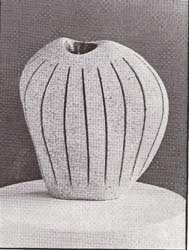For a number of years, sculptor Jim Ballard has been creating a series of vases. These pieces, made of basalt, granite, steatite, sandstone and marble, can be used for Ikebana (Japanese flower arranging), or for traditional western arrangements.
In May 1996, he showed a number of stone vases at the Lynnwood Library Gallery. Suzanne Meagher, an Ikebana teacher of the Sogetsu School, created arrangements in the vases and gave a demonstration ofthis ancient art to the general public.

CHOOSING THE STONE
JIM BALLARD: These vases, made from water-worn basalt and granite, are individually crafted from hand-picked stones. I often work by first fmding a stone or boulder that somehow interests me because of its texture, shape, color or some other characteristic. It might be a rough, half-buried stone in a field or a water-worn rock that I fmd on the beach. I'm always prepared to let certain stones visually jump out and make themselves known to me.
DESIGNING AND CARVING
Some of these stones of granite, basalt, serpentine, and marble line my driveway, where I walk by them day after day. In my head, I turn them around, studying the best way to texture, cut or polish them. How do I unity this shape with the shapes on the other side? Will this piece work vertically or horizontally? Do I leave some of the tool marks or should I polish the surface to a mirror fmish? I often make clean, straight cuts into the rough surface of stones, hoping for a pleasing contrast. Sizes range from about six inches to thirty inches in height.
Each vase is cored to a depth that ensures that the flower stems will remain in water for a number of days. The diameter of the hole is specific to the shape and size of the stone. Most of the core holes are from one inch to three inches in diameter, openings that will allow you to create single-stem flower arrangements as well as bouquets. I core most vertical vases using a diamond bit and then seal the resulting hole with water-resistant epoxy. I sometimes pressure wash the vase's surface to reveal more of the stone's inner colors.
FLOWER ARRANGING
Stone vases make excellent containers for flower arranging. By utilizing the natural elements of stone--rich colors, organic shapes and textures--these vases complement the lines of flower arrangements. Natural stone adds to the overall effect. Flower stems and other plant material can be secured by kenzans (needlepoint holders) placed at the bottom of the cored hole. Or stems can be held in place with screening material or other kinds of wedges. The core hole and the outside of the vase can easily be cleaned with warm water and soap.
DISPLAYING THE VASE
An excellent way of displaying a stone vase is to place it atop a marble tile. Tiles can be purchased in numerous sizes and colors. A six- by six-inch square of black or white marble makes a particularly attractive base. Some vases can be displayed on the floor, allowing you to use long branches in the flower arrangement; the weight of the stone will keep even the heaviest branches from toppling over or shifting out of place. Let your imagination run free when choosing materials to place in the vase. In addition to live plant material, use items like copper wire, dried leaves, and even beautifully shaped stones if they enhance the form of the vase. Don't be afraid to experiment--some ideas that may at first seem farfetched can produce excellent results. For example, the texture of dried chive blossoms alongside corkscrew willow branches nicely complements the rough texture of a basalt or granite vase.
I enjoy the challenge of making vases. Although I carve fish, birds and other animals, I always make time for this ancient form, the receptacle. Our house is a testing area for each new sculpture. Our home is ablaze with the color of flowers.
Of Note: In addition, Jim Ballard creates fountains and two dimensional art in various mediums. He is also an accomplished photographer and published writer. In 1993, he and Richard Hestekind completed a $30,000 commissioned granite stage with monolithic granite figures, at the Meadowdale Playfields. It is an extraordinary arrangement sculptures located in a setting which serves the family and community. This ambitious project was cosponsored by the cities of Edmonds and Lynnwood, W A.

